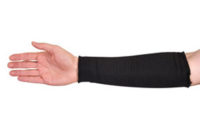Can hand protection cause a respiratory hazard? That’s the question scientists from the National Institute of Occupational Safety and Health (NIOSH) set out to answer when they conducted a Health Hazard Evaluation at a steel mill in Pennsylvania. The process yielded results that went beyond the efficacy of personal protective equipment to uncover an adverse safety culture that had a chilling effect on employees’ willingness to report real or perceived safety problems.
Sleeves were shedding fiberglass fibers
The evaluation was done in response to a request from employee and union representatives at the plant who were concerned about the potential for respiratory illness from fiberglass fibers being shed from cut-resistant sleeves. They also cited skin irritation, safety and hygiene problems from the required use of these sleeves.
The evaluation began with a visit to the steel mill in November, 2011 that included a tour of the plant to see how cut-resistant sleeves are used. While there, researchers collected tape and vacuum samples from work surfaces, cut-resistant sleeves and employee clothing and skin (fiberglass fibers were found on surface, clothing, and skin samples). Bulk samples of new and washed cut-resistant sleeves were also gathered for examination.
Additionally, NIOSH investigators talked to employees about their respiratory and other health concerns related to the sleeves. Workers reported numbness and/or pain in the hands or wrists from wearing the sleeves with thick gloves, probably due to awkward hand and wrist positions and the extra force needed to grip tools. Some had steam burns and itchy, irritated skin. There were also discussions about heat stress, poor hygiene practices, and safety hazards associated with the sleeves.
Fear of disciplinary action
NIOSH also found that most employees they spoke with were uncomfortable reporting work-related injuries and illnesses or telling their supervisor about their safety and health concerns. They felt that reporting would lead to disciplinary action. (NIOSH’s subsequent review of the OSHA injury and illness logs and employee medical records found that the company reported one-tenth the number of entries of the U.S. steel industry average).
Off-site, the NIOSH investigators identified the type, shape, and size of fibers collected from all of the samples and reviewed the OSHA injury and illness logs and employee medical records.
NIOSH’s conclusions: The size and shape of the fibers shedding from the sleeves make them difficult to inhale into the lungs. The composition and size of these fibers make them unlikely to cause any long-term health problems. However, the fiberglass fibers could cause temporary upper respiratory irritation.
Based on the evaluation results, NIOSH recommended that the company provide a different type of cut-resistant sleeve from the ones they had been wearing for employees who have skin irritation, hand or wrist pain, and provide new and washed cut-resistant sleeves in more locations that are easy to get to throughout the steel mill, including employee locker rooms. Employees should be trained on how to care for, maintain and dispose of the sleeves. When returned by the laundry service, sleeves should be checked to make sure they are adequately cleaned.




